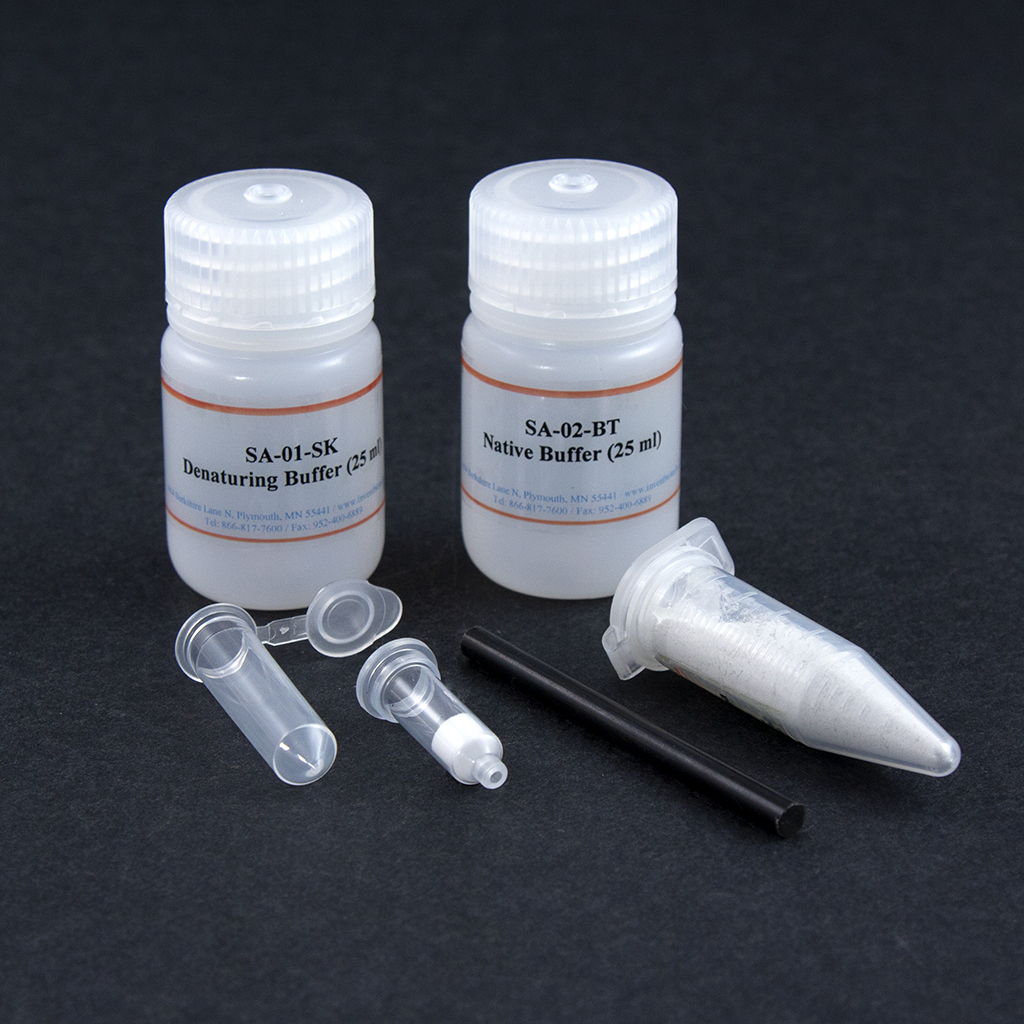Shipping calculated at checkout
Couldn't load pickup availability
Questions about this product? Ask our scientist!
Minute™ Total Protein Extraction Kit for Skin Tissue (50 Preps)
SKU:Cat #: SA-01-SK
Manual & Protocol | MSDS
Skin tissue is made up of epidermis, dermis and subcutaneous fat. Because of its unique structure, skin tissue is notoriously difficult to homogenize. It is also very difficult to lyse the cells in the tissue for total protein extraction. Traditional solution-based protein extraction methods, such as RIPA, are inefficient and the yield is very low. The profile of extracted protein is also incomplete with solution-based methods. This kit provides a highly efficient method for total protein extraction from human or animal skin tissues by using a combination of mechanical extraction and chemical lysis of skin tissues. The kit features a simple and fast single-tube protocol and optimized buffers for skin tissues. The researchers have the option to choose either a denaturing or native cell lysis buffer, which is specifically tailored for skin tissue. The whole procedure takes less than 10 minutes to complete and the protein yield is in the range of 1-5 mg/ml. The materials provided are sufficient for 50 extractions.
Shipping and storage: This kit is shipped and stored at room temperature.

|
Items
|
Quantity |
|
Denaturing Buffer |
25 ml |
|
Native Buffer |
25 ml |
|
Protein Extraction Powder |
5g |
|
Plastic Rods |
2 units |
|
Filter Cartridges |
50 units |
| Collection Tubes | 50 units |
References (11)
- Zhang, C., Li, Y., Qin, J., Yu, C., Ma, G., Chen, H., & Xu, X. (2021). TMT-Based Quantitative Proteomic Analysis Reveals the Effect of Bone Marrow Derived Mesenchymal Stem Cell on Hair Follicle Regeneration. Frontiers in Pharmacology, 12.
- Wang, T., Zhu, G., Qin, L., Wang, Q., She, C., Xu, D., ... & Li, S. T. (2021). Kininogen–Nitric Oxide Signaling at Nearby Nonexcited Acupoints after Long-Term Stimulation. JID Innovations, 1(3), 100038.
- Yin, S., Song, R., Ma, J., Liu, C., Wu, Z., Cao, G., ... & Wang, Y. (2022). Receptor activity‐modifying protein 1 regulates mouse skin fibroblast proliferation via the Gαi3-PKA-CREB-YAP axis. Cell Communication and Signaling, 20(1), 1-18.
-
Wang, Y., Huang, J., & Jin, H. (2022). Reduction of Methyltransferase-like 3-Mediated RNA N6-Methyladenosine Exacerbates the Development of Psoriasis Vulgaris in Imiquimod-Induced Psoriasis-like Mouse Model. International Journal of Molecular Sciences, 23(20), 12672.
- Zhu, W., Dong, Y., Xu, P., Pan, Q., Jia, K., Jin, P., ... & Che, B. (2022). A composite hydrogel containing resveratrol-laden nanoparticles and platelet-derived extracellular vesicles promotes wound healing in diabetic mice. Acta Biomaterialia.
- Yuan, X., Tang, B., Chen, Y., Zhou, L., Deng, J., Han, L., ... & Wang, Y. (2023). Celastrol inhibits store operated calcium entry and suppresses psoriasis. Frontiers in Pharmacology, 14.
- Zhou, H., Gan, Y., Li, Y., Chen, X., Guo, Y., & Wang, R. (2023). Degradation of Rat Sarcoma Proteins Targeting the Post-Translational Prenyl Modifications via Cascade Azidation/Fluorination and Click Reaction. Journal of Medicinal Chemistry.
- Wang, J. Study on the Regulatory Mechanism of Jia Wei Guo Min Decoction On Degranulation of Mast Cell in Ad Mice Based on His/Par-2 Pathway.
- Huang, J. L., Xu, Y. H., Yang, X. W., Wang, J., Zhu, Y., & Wu, X. B. (2023). Jiawei guomin decoction regulates the degranulation of mast cells in atopic dermatitis mice via the HIS/PAR-2 pathway. Journal of Ethnopharmacology, 117485.
- Wu, Z., Liu, C., Yin, S., Ma, J., Sun, R., Cao, G., ... & Wang, Y. (2024). P75NTR regulates autophagy through the YAP-mTOR pathway to increase the proliferation of interfollicular epidermal cells and promote wound healing in diabetic mice. Biochimica et Biophysica Acta (BBA)-Molecular Basis of Disease, 167012.
- Xu, X. L., Wu, S. J., Qi, S. Y., Chen, M. M., Liu, Z. M., Zhang, R., ... & Lian, Z. X. (2024). Increasing GSH-Px Activity and Activating Wnt Pathway Promote Fine Wool Growth in FGF5-Edited Sheep. Cells, 13(11), 985.

